Heyworth Building
Appearance
This article needs additional citations for verification. (January 2011) |
| Heyworth Building | |
|---|---|
 | |
 | |
| General information | |
| Address | 29 E. Madison Street |
| Town or city | Chicago, Illinois |
| Country | United States |
| Coordinates | 41°52′55″N 87°37′36″W / 41.8819°N 87.6267°W |
| Opened | 1904 |
| Technical details | |
| Floor count | 19 |
| Floor area | 256,000 square feet (23,800 m2) |
| Design and construction | |
| Architect(s) | Frederick P. Dinkelberg |
| Architecture firm | D. H. Burnham & Company |
Chicago Landmark | |
| Designated | September 27, 2000 |
The Heyworth Building is a
Chicago, Illinois
.
The building was constructed in 1904 by the architectural firm of
jeweler. It received its name from Lawrence Heyworth, the son-in-law of Otto Young, who also supervised construction of the building. Like many other buildings along Wabash Avenue, the Heyworth historically housed watchmakers, jewelers, and associated businesses. This structure was one of the final buildings designed by Frederick P. Dinkelberg at the firm before administration was turned over to Ernest Robert Graham.[1]
The Heyworth stands 19 stories tall with a gross square footage of 256,000 square feet (23,800 m2). Its style strays from the typical designs of
Chicago School's structurally expressive character with decorative appearance common in traditional masonry architecture. The tapestry-like ornament of the building pairs well with the ornamentation designed by Louis Sullivan on the adjacent Sullivan Center building. The Heyworth is also noted for its intact finely crafted decorative cornice, which is an uncommon feature among the other commercial buildings of Chicago. The building was designated a Chicago Landmark on September 27, 2000.[1]
According to a real estate firm that manages the property, the height of the building is listed in various documents as 260 or 273 or 282 feet (79 or 83 or 86 m).[citation needed]
The building underwent an $11 million (equivalent to $19.5 million in 2024)MacCormac College in Chicago and to the Center for Economic Progress.
See also
- Chicago school (architecture)
- Chicago architecture
References
- ^ a b "Heyworth Building". Chicago Landmarks. Retrieved April 6, 2024.
- ^ 1634–1699: McCusker, J. J. (1997). How Much Is That in Real Money? A Historical Price Index for Use as a Deflator of Money Values in the Economy of the United States: Addenda et Corrigenda (PDF). American Antiquarian Society. 1700–1799: McCusker, J. J. (1992). How Much Is That in Real Money? A Historical Price Index for Use as a Deflator of Money Values in the Economy of the United States (PDF). American Antiquarian Society. 1800–present: Federal Reserve Bank of Minneapolis. "Consumer Price Index (estimate) 1800–". Retrieved February 29, 2024.
